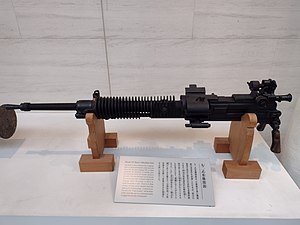|
Type 92 heavy machine gun
The Type 92 heavy machine gun (九二式重機関銃, Kyūni-shiki jū-kikanjū) is a Japanese heavy machine gun, related to the Hotchkiss machine gun series. It entered service in 1932 and was the standard Japanese heavy machine gun used during World War II. The Type 92 was similar in design to the earlier Type 3 heavy machine gun but chambered to fire the improved 7.7mm rimmed or semi-rimmed round. Known for its reliability,[3] it was used after the war by various forces in East Asia. Designed by Kijiro Nambu and built by Hino Motors and Hitachi, its total production was about 45,000 guns.[4] Type 92 refers to the Japanese Imperial year 2592 – 1932 in the Gregorian calendar – in which the gun entered service.[5] DesignThe Type 92 was essentially a scaled-up version of the Type 3 heavy machine gun, with its calibre increased to 7.7 mm, and like the Type 3 was air cooled, ammo strip-fed, and based on the Hotchkiss M1914.[6] It could use both a rimless and semi-rimmed 7.7×58mm Shiki round.[7] A 7.7mm Arisaka round could be used if necessary or if other ammunition supplies dwindled.[5] Rounds fired from the gun traveled at about 730 m/s (2,400 ft/s), and the rate of fire was about 450 rpm. It was sometimes used as a light anti-aircraft gun during the Pacific War. It was nicknamed "the woodpecker" by Western Allied soldiers because of the characteristic sound it made when fired due to its relatively low rate of fire, and the "chicken neck" (Chinese: 雞脖子) by Chinese soldiers due to its appearance.[7] The Type 92 had a maximum range of 4,500 meters, but a practical range of 800 meters. The gun was intended to be fired on a tripod with a team of three men. The tripod was designed with removable carry poles, so that the weapon could be transported fully assembled for quicker deployment.[5] An unusual characteristic of this gun was the placement of its iron sights – canted slightly to the right instead of the centre. A number of different sights were produced for the weapon, the Type 93 and Type 94 periscopic sights as well as the Type 96 telescopic sight. A ring-type anti-aircraft sight was also produced. Problems with this weapon included the use of 30-round feed strips, which did not allow for as high a volume of fire as a belt-fed gun, and the oiler, which enabled better extraction in clean conditions but could bring dirt inside the gun in the field. The gun has an internal oil pump which is mechanically activated by the bolt. The oil pump dispenses a small amount of oil onto a brush, which then lubricates each cartridge as it is fed into the gun.[8] Combat historyThe Type 92 was used extensively by the Imperial Japanese Army and collaborationist Chinese forces.[7] Captured weapons were also used by Chinese troops against the Japanese during World War II,[9] the Korean People's Army against the United Nations forces during the Korean War,[7] the Viet Minh against the CEFEO forces during the First Indochina War,[3] and the Indonesian Army against the Netherlands forces during the Indonesian National Revolution.[10] Users
See alsoGallery
References
External linksWikimedia Commons has media related to Type 92 heavy machine gun.
|
||||||||||||||||||||||||||||||||||||||||||||||||||
Portal di Ensiklopedia Dunia






